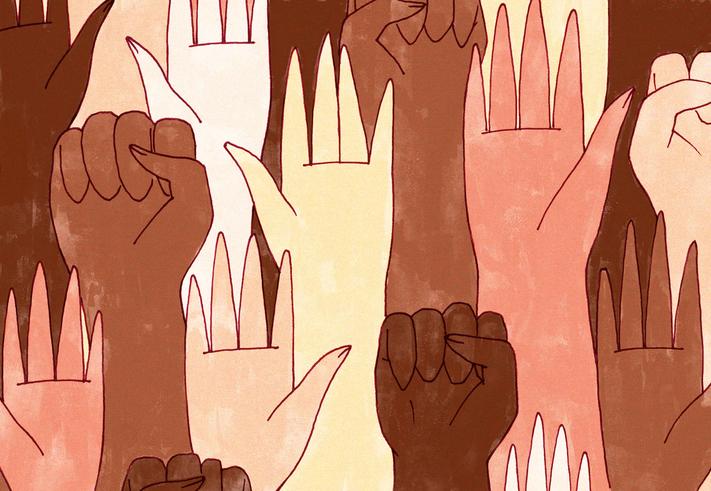
The problem with equity, diversity and inclusion in a multiracist world
EDI initiatives are commonplace in Western higher education. They pay little or no attention to the global diversity of racism. But should they, asks Alastair Bonnett

Racism has many roots and routes. From China to Myanmar, Syria to Morocco, discrimination against ethnic and racial minorities is often severe and blatant. Today, EDI (equity, diversity and inclusion) initiatives are commonplace in UK higher education. They pay little or no attention to the global diversity of racism. But should they? It is a question I’ve been asked since the publication of Multiracism: Rethinking Racism in Global Context, my book that tries to explain racism across Asia and Africa.
The question registers a dissatisfaction with the limited horizons of EDI and, initially, I pushed it away. EDI programmes do not claim to be offering global perspectives but institution-level measures that make universities more accessible and fairer places to work and study. I’ve spent decades working in the sector and they are one of the few concrete signs of progress I can point to.
- Diversity efforts in academia are leading us towards ‘the oppression Olympics’
- It’s time to change the narrative on affirmative action
- Can we really decolonise the university?
EDI is not in crisis and appears to be broadly supported by staff. Yet this does not mean it should be sealed from the world or trapped in an Anglo-America echo chamber. Bureaucracies tend towards one-size-fits-all processes: resources are rolled out loaded with predetermined assumptions and categories, whereas a more globally aware approach might help EDI become lighter on its feet and more effective.
Any encounter with the diversity of racism is also an encounter with the diversity of diversity. What I mean by this is that what “diversity” means – what it is called, what it looks like and what its impacts are – is not the same everywhere. People from the US and, increasingly, Europe, who have become accustomed to thinking of diversity in terms of skin colour, often have trouble seeing the kind of diversity that exists elsewhere.
I have heard, more than once, white British people describe China as “homogeneous”. The same even goes for India. These representations are not just an embarrassing faux pas but a fundamental misreading. They reflect a lack of awareness about the multiple ways discrimination is understood and named. In India, for example, “communalism” and “casteism” are often used to depict exclusionary practices and ideologies. I recall during fieldwork in Peru being told repeatedly by activists that they preferred the term “cholism” (“cholo” being a slang for people of mixed descent) to “racism” because it represented the specific realities they were dealing with. These examples could be replicated many times over: diversity and inclusion have many stories.
This insight can also be applied to colonisation. Given the take-up of decolonial agendas in EDI, it is important to recognise that the experience of colonisation far exceeds the history of what the West did to “the rest”. European colonialism has been handed on, adapted, adopted and, in some cases, intensified in “post-colonial” nations, one of the better-known examples being the Indonesian state’s relationship to West Papua. An international viewpoint also brings into focus the political complexity of the decolonial challenge. The USSR was an anti-colonial state but it was also an empire. The idea and history of “red racisms”, introduced by the sociologist Ian Law in his studies of racism in the USSR but also communist China and Cuba, evidences the political range and flexibility of racism.
Our ability to see this diversity is shaped by the language we use. EDI policies routinely foreground the language of “race”. Yet “race” is not a globally accepted term. A survey conducted by the sociologist Ann Morning – sampling census forms from 141 countries – found that only 15 per cent asked for respondents’ “race” and that this usage was confined largely to “the former slaveholding societies of the Western Hemisphere and their territories”. If we limit our interest in racism to places where the language of race is to the fore or dominant, we look at a small part of the world.
Moreover, the vocabularies and claims that swirl around racism are fluid and changing fast. Today, many activists employ the term “racism”, including Dalits and Muslims in India, Rohingya in Myanmar, Uighur in China, Yazidis in Syria and Papuans in Indonesia. Racism can no longer be understood as something that is defined and verified by a canon of Western experts. It is a tool, wielded by people desperate to call attention to their plight. The geography of “racism” is being expanded and many new “racisms” are being asserted and identified.
EDI initiatives that offer a fixed model of discrimination, based on a model of white power and dominance, are unable to engage the shifting and multifarious nature of modern racisms. It might seem obvious why this matters but, in practical, day-to-day, terms, it also matters because universities are international communities: staff and students do not arrive as cultural tabula rasa but bring with them a range of expectations and beliefs about human difference. This multiplicity is better framed as an asset than a problem. The West is neither the locus of world history nor the epicentre of all the world’s racisms and anti-racisms. We need to learn from and listen to many voices.
Putting these observations into practice means framing the international nature of the academic community as a resource, allowing traditions and experiences from outside the Anglosphere to be acknowledged, encountered and learnt from. This is not the same thing as expecting colleagues from Asia and Africa to “speak to” or “open up” about topics that they might, for many reasons, wish not to talk about. The onus should be on institutions and EDI facilitators to build on and engage global knowledge, including examples of best practice. This can be as simple as looking at the international press from the past few years; a little curiosity about the world beyond the Anglo-American “race debate” would go a long way.
The forms we fill in and the training we do need to fit a format and be replicable. In some ways the homogenisation of EDI, “McEDI”, is inevitable. Clear and definable outcomes have to be obtained and shown to be obtainable. Where this process becomes problematic is when it prevents a sufficient acknowledgment of the changing and varied nature of the problem it seeks to address. When that happens EDI becomes simplistic, performative and out of touch.
Understanding diversity, and the interweaving of its many threads, is an ongoing task. It is not a done deal. It also requires an appreciation that there is no universal “up escalator” towards diversity and tolerance. It is a sentiment that might, to some, appear obvious but is worth saying because the notion that diversity is baked into the modern world – and that we just need to “respond” to it – is widespread. The claim that we live in “an increasingly diverse world” is the basis of the League of European Research Universities’ “Manifesto for an inclusive university”. This might make sense when you live in Berlin, London or New York. You look out of the window; you see a certain type of diversity, so that’s the world.
A less Eurocentric and less metro-centric perspective tells us that the ascent of diversity is not just uncertain but in peril. Much of the planet is less diverse than it was 100 years ago. Many minorities have almost or entirely disappeared, while the mass extinction of languages points to the homogenisation rather than the profusion of identities. This is a sombre reality, but it’s also necessary knowledge. It tells us that equity, diversity and inclusion are neither inevitable nor everywhere but hard won and easily lost.
Alastair Bonnett is a professor of geography at Newcastle University, UK. His latest book is Multiracism: Rethinking Racism in Global Context. His previous books on racism and ethnicity include Radicalism, Anti-racism and Representation; White Identities: Historical and International Perspectives; Anti-racism; and The Idea of the West.
If you would like advice and insight from academics and university staff delivered direct to your inbox each week, sign up for the THE Campus newsletter.


